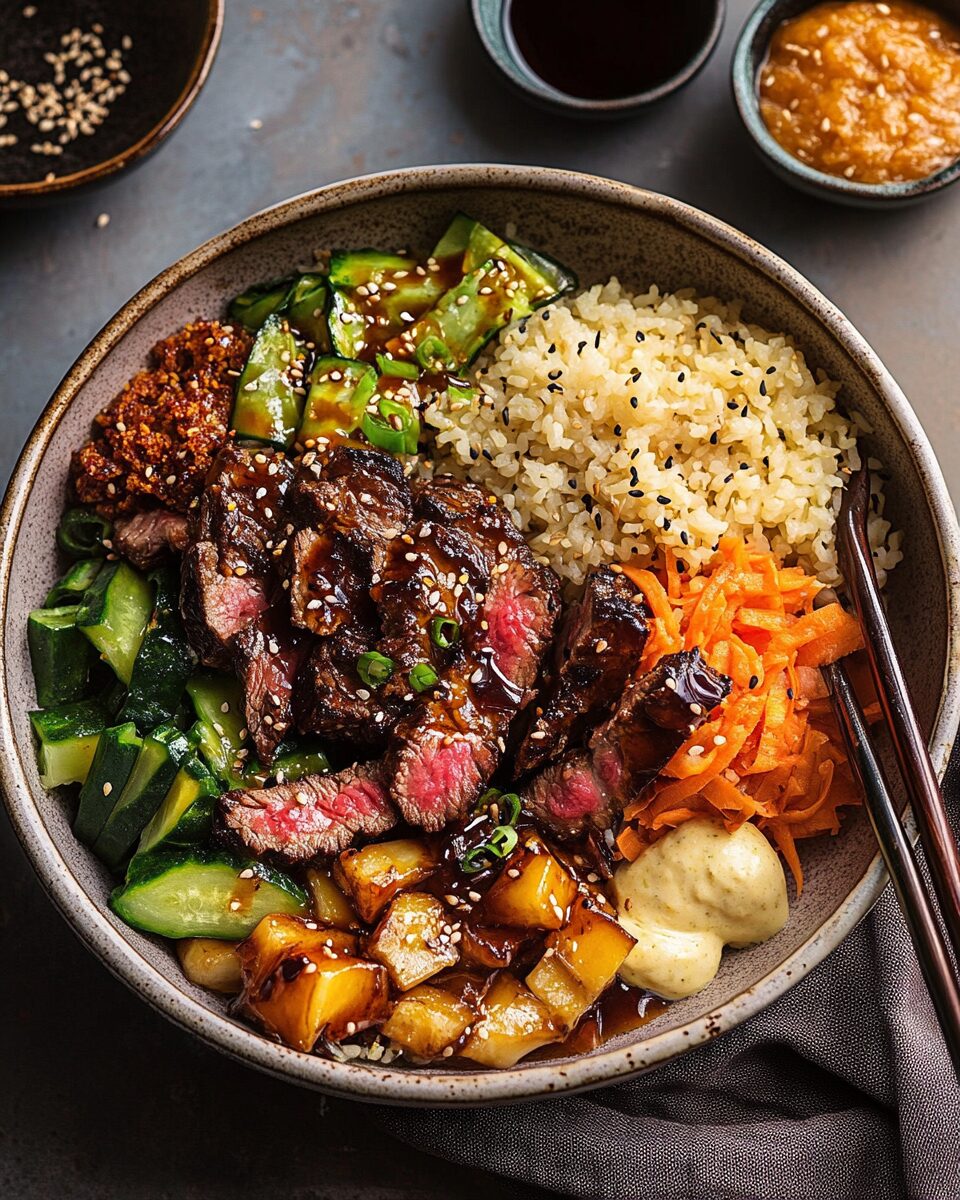Transport yourself to a Japanese steakhouse with these Hibachi Steak Bowls, packed with juicy steak, tender-crisp vegetables, and fluffy jasmine rice. The creamy, tangy Yum Yum Sauce ties everything together, making each bite irresistibly delicious.
This dish is perfect for a quick weeknight dinner or an impressive meal to share with guests. The combination of savory steak, vibrant veggies, and creamy sauce makes it a crowd-pleaser. Plus, it’s a versatile recipe that you can easily adapt to your preferences. Get ready to enjoy restaurant-quality flavors at home!
Full Recipe:
Ingredients:
- 1 lb steak (ribeye or sirloin), thinly sliced
- 2 tbsp soy sauce
- 2 tbsp sesame oil
- 1 tbsp garlic, minced
- 1 tbsp ginger, minced
- 1 cup zucchini, chopped
- 1 cup mushrooms, sliced
- 1 cup carrots, julienned
- 3 cups cooked jasmine rice
- 2 tbsp butter
- 1 tbsp sesame seeds, toasted
- Salt and pepper to taste
Yum Yum Sauce:
- 1/2 cup mayonnaise
- 1 tbsp ketchup
- 1 tsp rice vinegar
- 1 tsp paprika
- 1/2 tsp garlic powder
- 1/2 tsp sugar
- 1-2 tbsp water (for desired consistency)
Directions:
- Marinate the Steak: In a bowl, combine soy sauce, sesame oil, garlic, and ginger. Add the thinly sliced steak and marinate for 15-20 minutes.
- Cook the Steak: Heat a large skillet or wok over medium-high heat. Add the marinated steak and cook for 3-4 minutes until browned. Remove from the pan and set aside.
- Sauté the Vegetables: In the same skillet, melt butter. Add zucchini, mushrooms, and carrots. Sauté for 4-5 minutes until tender yet slightly crisp. Season with salt and pepper.
- Prepare the Yum Yum Sauce: In a small bowl, whisk together mayonnaise, ketchup, rice vinegar, paprika, garlic powder, sugar, and water until smooth.
- Assemble the Bowls: Divide the cooked jasmine rice into serving bowls. Top with the sautéed vegetables and cooked steak. Drizzle with Yum Yum Sauce.
- Garnish and Serve: Sprinkle with toasted sesame seeds and serve immediately.
Prep Time: 20 minutes | Cooking Time: 20 minutes | Total Time: 40 minutes
Kcal: 485 kcal | Servings: 4 servings
History and Origin
Hibachi-style cooking originates from Japan and traditionally involves grilling meats and vegetables over an open flame on a small portable grill, known as a hibachi. While the concept has evolved, especially in Western interpretations, the core idea of cooking fresh, flavorful ingredients quickly remains the same. Hibachi is synonymous with communal dining, showmanship, and bold flavors, making it a favorite in Japanese steakhouses around the world.
Flavor Profile
The Hibachi Steak Bowls deliver a symphony of flavors. The steak is marinated in a combination of soy sauce, sesame oil, garlic, and ginger, giving it a savory and slightly nutty profile with hints of umami. The sautéed vegetables add freshness and texture, while the creamy Yum Yum Sauce balances everything with its tangy and mildly sweet finish.
Customization Options
This recipe is highly versatile, making it easy to customize based on dietary preferences or available ingredients:
- Protein: Swap steak with chicken, shrimp, tofu, or even salmon for a unique twist.
- Vegetables: Add broccoli, snap peas, or bell peppers for added crunch and color.
- Rice Alternatives: Replace jasmine rice with fried rice, brown rice, or cauliflower rice for a low-carb option.
- Yum Yum Sauce: Adjust the sauce’s sweetness or tanginess by tweaking the sugar and vinegar proportions.
Tips for Success
- Cutting the Steak: For the most tender results, slice the steak against the grain. This shortens the muscle fibers, making the meat easier to chew.
- Cooking Heat: Use a high heat setting to achieve a nice sear on the steak and vegetables, which locks in flavor and gives the dish its signature texture.
- Prep Ahead: Marinate the steak and prepare the Yum Yum Sauce in advance to save time during cooking.
Pairing Suggestions
To complete the meal, pair your Hibachi Steak Bowls with:
- A light miso soup or Japanese clear soup as a starter.
- A side of pickled vegetables like daikon or kimchi to cut through the richness.
- Japanese-inspired desserts like mochi or green tea ice cream for a sweet finish.
Fun Facts
- The term “hibachi” literally means “fire bowl” in Japanese, referring to the open-grill cooking method.
- Yum Yum Sauce, though popular in Western hibachi restaurants, is an American creation and is not traditionally found in Japan.
What Makes Hibachi Unique?
Hibachi cooking is all about quick, high-heat preparation that locks in the natural flavors of the ingredients. While traditionally done on a charcoal grill, the method can easily be adapted for home kitchens using a skillet or wok. The hallmark of this style lies in its simplicity—allowing the freshness and quality of ingredients to shine.
Why You’ll Love This Recipe
- Quick and Easy: With only 40 minutes from start to finish, it’s perfect for busy weeknights.
- Balanced Nutrition: This dish includes protein, carbohydrates, and a variety of vegetables, making it a wholesome and satisfying meal.
- Restaurant-Style at Home: You can recreate the flavors of a Japanese steakhouse without leaving your kitchen.
Key Ingredients and Their Roles
- Steak: Ribeye or sirloin works best due to their tenderness and rich flavor. Thinly slicing the steak ensures even cooking and allows the marinade to penetrate fully.
- Soy Sauce and Sesame Oil: These foundational ingredients add depth, umami, and a nutty aroma to the dish.
- Fresh Vegetables: Zucchini, mushrooms, and carrots provide vibrant color, texture, and a nutritional boost.
- Jasmine Rice: Its light, fluffy texture pairs perfectly with the bold flavors of the steak and sauce.
- Yum Yum Sauce: This creamy, tangy condiment elevates the dish, offering a delightful contrast to the savory steak and vegetables.
Cooking Techniques
- Marinating for Flavor: Allowing the steak to marinate ensures the meat is tender and infused with flavor.
- High Heat Cooking: Searing the steak and vegetables over high heat creates a slight char, which enhances the overall taste and authenticity.
- Sauce Consistency: To achieve the perfect Yum Yum Sauce, whisk until smooth and adjust the water for your desired consistency.
Dietary Modifications
- Gluten-Free: Substitute soy sauce with tamari or coconut aminos.
- Low-Carb/Keto: Use cauliflower rice instead of jasmine rice.
- Dairy-Free: Omit butter or replace it with plant-based alternatives.
- Vegan Option: Replace the steak with tofu or tempeh and adjust the Yum Yum Sauce with vegan mayonnaise.
Presentation Tips
- Use bowls or plates with a neutral color to make the vibrant steak and vegetables stand out.
- Sprinkle sesame seeds or finely chopped scallions over the finished dish for a professional touch.
Interesting Trivia
- Hibachi meals are often associated with theatrical presentations in restaurants, where chefs prepare food on a flat grill in front of diners.
- In Japan, hibachi grills are often used for home cooking and are much smaller than the teppanyaki grills seen in Western hibachi restaurants.
Storing and Reheating
- Storage: Keep leftovers in an airtight container in the refrigerator for up to 3 days.
- Reheating: Heat in a skillet over medium heat with a splash of water or broth to maintain moisture. Avoid microwaving to preserve the texture of the steak and vegetables.
Conclusion
Hibachi Steak Bowls are more than just a meal; they’re an experience that brings the flavors of Japanese steakhouses into your home. Whether you’re hosting a dinner party or looking for a quick family meal, this recipe combines bold flavors, fresh ingredients, and easy preparation for a dish that’s sure to impress.






